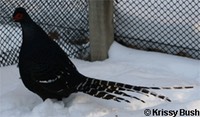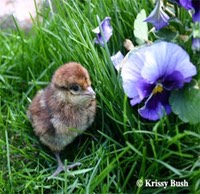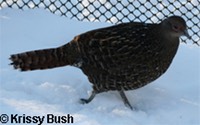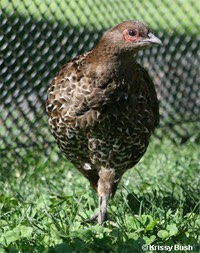By Donna Bush
Alberta, Canada
In the wild Mikados are found exclusively in the central mountain area of the island of Taiwan. They have been on the endangered list for a number of years, and there is no positive news of their numbers growing. In captivity, they are being bred successfully worldwide.
Mikados have proven exceptionally hardy in northern Alberta's climate and seem quite at home in the deep snow. They are particularly impressive on a cold, clear February day stately strutting across the new fallen snow, glossy purplish blue feathers glistening in the sunlight, high- lighted by their crisp white markings. They usually prefer the shelter of their housing during the day, but can always be seen out on their perches in the late afternoon and spend the entire night outside regardless of the weather.
Males perform an interesting display that is indicative of most of the long tailed males. Puffing up his feathers, flaring his brilliant wattles, with tail lowed and fully spread he will begin to whirr his wings. Next, he proceeds toward the nearest hen in his slow stately gait, as he gets closer to the hen, he drops his wing to the ground and his tail is spread tilted up and sideways. He will pace back and forth in front of the hen a few times. Then without any further notice he will initiate breeding. Usually the hen takes off running or flying for the nearest cover with him in hot pursuit making a whinning ehh, ehh, ehh noise. Mikados can be successfully bred in pairs or trios. I usually breed them in trios, as the cocks are particularly demanding on the hens and lots of cover should be provided for the hens during breeding season.
First year males are generally fertile to a limited extent, females almost always lay first year, but will usually lay about a dozen eggs or less. Hens can start laying at the end of March if the weather is really warm. Usually they start laying the first or second week in April, but have been known to hold off laying until late April, if we experience very cold and snowy weather. The average number of eggs per hen is usually 12-18 very large creamy white eggs, but this number can vary substantially as I had one hen that laid 33 eggs in one season. Fertility is usually good on cocks after the first year, but hens can get very sloppy with their laying after the first few eggs are taken. It is a good idea to provide the hens with several good laying spots.
Breeder Mikados are kept in grassy 10'x 25' pens with a 4'x 4'x 4' house in the center of the pen. 2-3 corners of the pen have a wooden teepee with straw in it, and are covered with spruce boughs from mid February to May. Grassy pens are particularly important for Mikados as they are real vegetation eaters. They also enjoy their diet to be supplemented with fresh fruits and vegetables, especially berries or tomato pieces.
Eggs are set daily in a Lyons Roll-X (RX2) incubator with grid 89. Temperature 99.8, Humidity- wet bulb 82 (Humidity is adjusted periodically depending on the development of the air space as determined by candling.) Incubation is 27-28 days. The chicks are cute little pudgy guys that soon run off their baby fat. The chicks are neither aggressive or timid and can be raised with a variety of other pheasant chicks for quite some time. When in groups of their own kind, both sexes can be kept together with a minimum of problems until well into the winter. The chicks can be sexed long before they are ready to sell as the males will start showing their black and white tail barring and black on the wing feathers. The biggest problem that we have had with the chicks is that they are great at escaping and with their little "monkey toes" they can easily climb up the side wire and out the top. Clipping the wing feathers on one or both wings usually corrects the problem, but occasionally we get a chick with both wings clipped cruising the tops of the pens or having a little snack in the garden. For complete information on how we raise chicks refer to the Copper article.
Descriptions of Mikados can be found in Beebe's "Pheasants -Their Lives and Homes", Delacour's "Pheasants of the World" or either edition of American Game Bird Breeders' Cooperative Federation "Pheasant Standards". For those who wanted to know what to look for if you are showing Mikados the descriptions in these books are very complete. I asked our resident "Fed boy" for his opinion. Both Male and female must be defect free, and in perfect feather and condition. Female: body color- dark not washed out, nice clear breast, wing and back makings, no broken patterns, even medium black barring in tail. Male: approx. 1/4" white bars, lightly speckled with black on 2 central tail feathers, approx. 3/8" to 1/2" white bars, lightly specked with black on other tail feathers (tail is not to appear grey), no white speckling on shoulders, greater wing-coverts black with broad white tips forming a noticeable bar, secondaries and tertiaries black with small white tips.
If you a looking for a long-tailed pheasant that is a little more challenging than the Reeves or Elliots, the Mikado pheasant is an excellent choice. They are hardy, quiet, very showy and tame.



